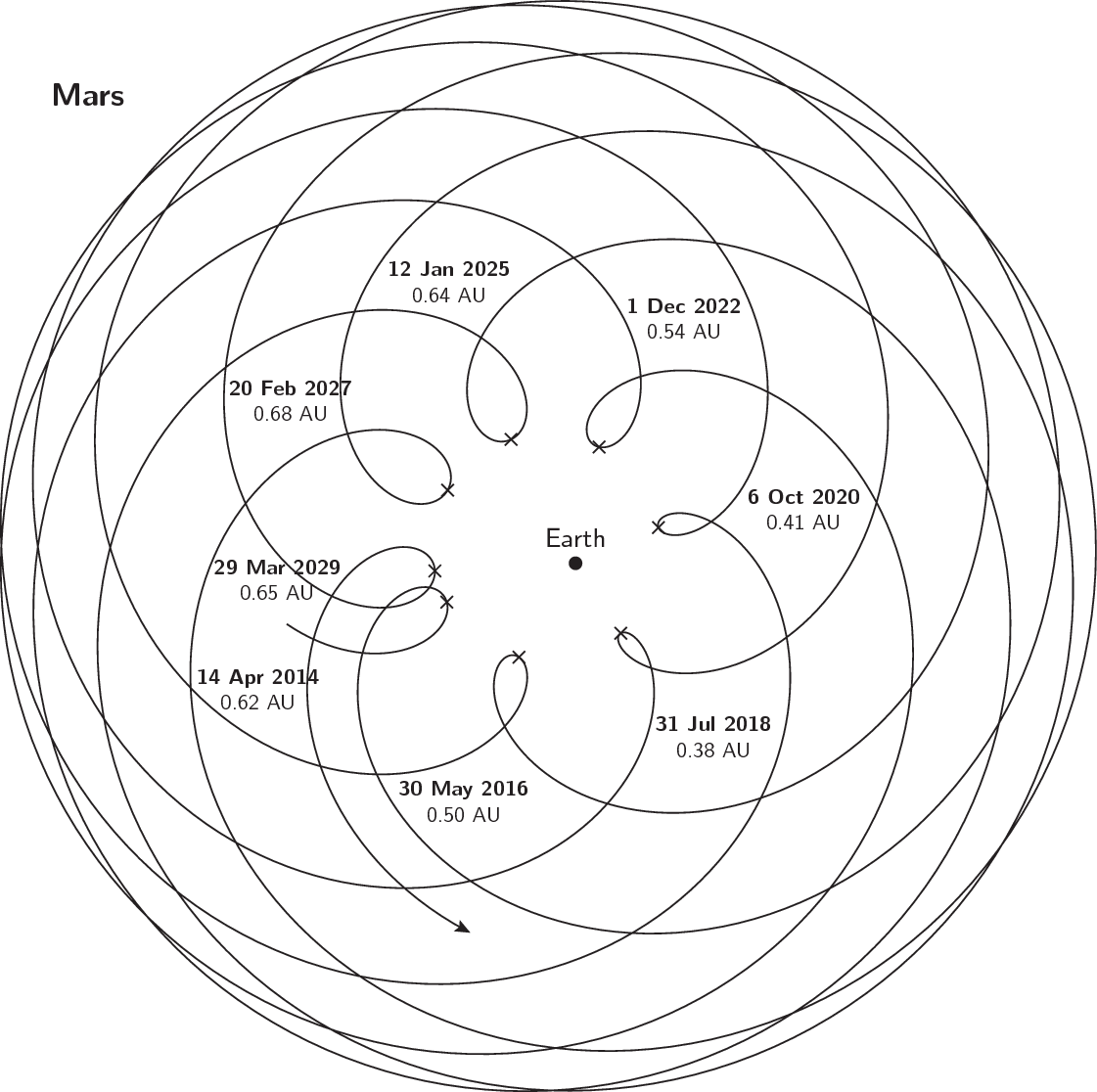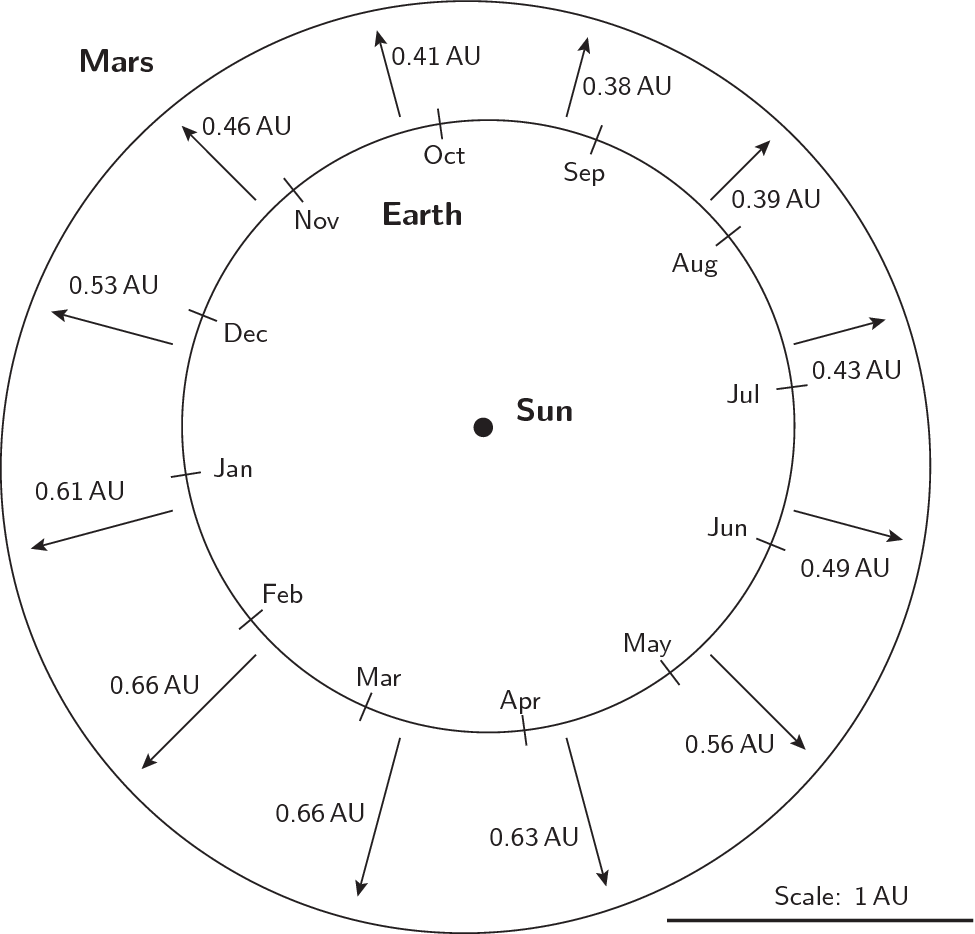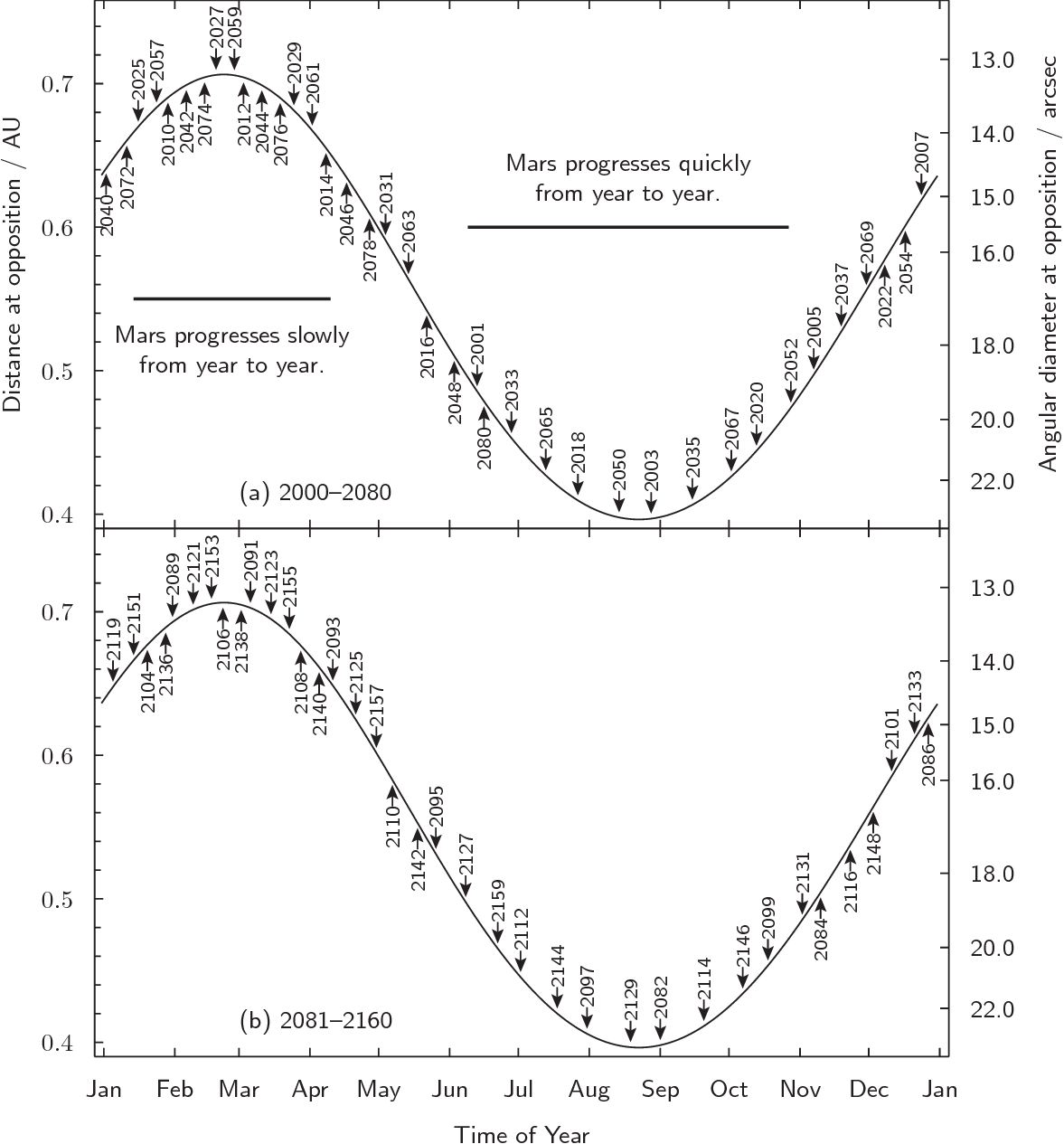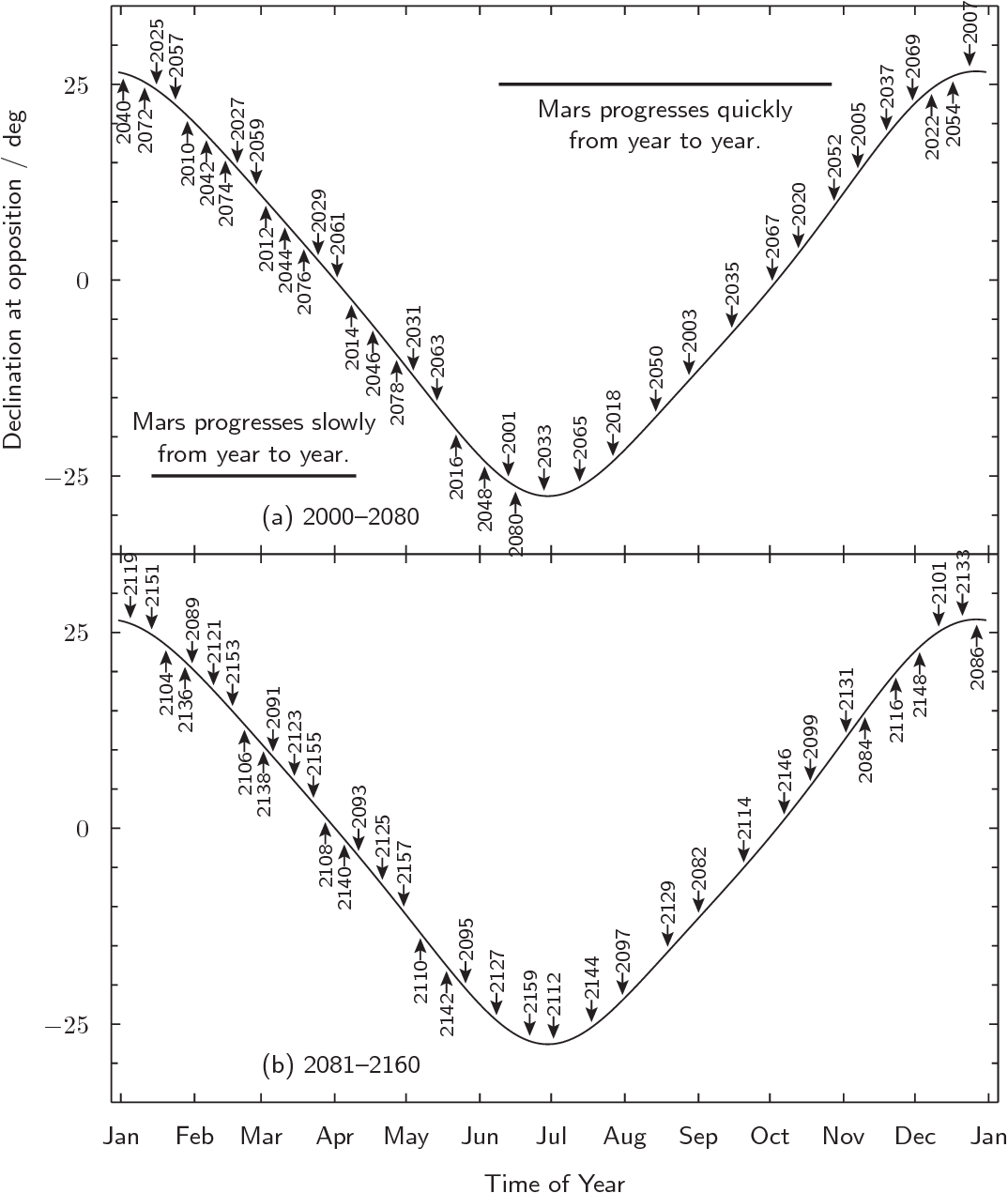Mars
The planets of the solar system:
Mercury
Venus
Earth
Mars
Jupiter
Saturn
Uranus
Neptune
Mars will soon pass behind the Sun at solar conjunction. From South El Monte, it is not readily observable since it is very close to the Sun, at a separation of only 1° from it.
| 23 Feb 2025 | – Mars ends retrograde motion |
| 10 Jan 2027 | – Mars enters retrograde motion |
| 19 Feb 2027 | – Mars at opposition |
| 19 Feb 2027 | – Mars at perigee |
Mars, as seen by the Hubble Space Telescope in 2001. Image courtesy of NASA.
Mars is the fourth planet from the Sun, orbiting it at a distance of 1.52 AU, once every 687 days.
It is also our neighbour in the solar system, orbiting just outside the Earth's orbit, and is a small planet – the second smallest in the solar system after Mercury, measuring only 53% of the Earth's diameter.
In the night sky, Mars appears with a distinctly red color which is apparent even to the unaided eye. This is the result of a high abundance of iron oxide – rust – in its soil.
Through a telescope, its polar regions often appear to have a markedly whiter hue. Its surface features appear as subtle dark markings on its surface, whose brightness contrasts are often easier to see with the help of color filters.
Apparitions of Mars
The table below lists apparitions of Mars around the year 2026, computed from NASA's DE430 planetary ephemeris. To show events around other years, use the control below.
Apparitions of Mars around 2026
| Date | Event | Declination | Angular size |
| Date | Event | Declination | Angular size |
| 26 Jul 2018 22:06 PDT | Mars at opposition | 25°33'S | 24.3" |
| 13 Oct 2020 16:19 PDT | Mars at opposition | 5°20'N | 22.3" |
| 07 Dec 2022 21:35 PST | Mars at opposition | 24°57'N | 17.0" |
| 15 Jan 2025 18:32 PST | Mars at opposition | 25°10'N | 14.5" |
| 19 Feb 2027 07:44 PST | Mars at opposition | 15°30'N | 13.8" |
| 25 Mar 2029 00:42 PDT | Mars at opposition | 1°13'N | 14.4" |
| 04 May 2031 04:57 PDT | Mars at opposition | 15°20'S | 16.8" |
| 27 Jun 2033 18:23 PDT | Mars at opposition | 27°50'S | 21.9" |
| 15 Sep 2035 12:31 PDT | Mars at opposition | 8°14'S | 24.5" |
Mars's orbit
Mars comes to opposition once every 780 days (2.1 years) – its synodic period. Because it lies close to the Earth in the solar system, its distance from the Earth varies dramatically over this 780-day cycle.
When the two planets are next to one another in their orbits – the moment when Mars appears at opposition, their separation can be less than 0.4 AU.
By contrast, when the two planets are opposite one another in the solar system – the moment when Mars appears at solar conjunction – their separation can exceed 2.6 AU.
As a consequence, the size of Mars's disk also changes dramatically: at solar conjunction it is a small and distant speck measuring only 3.5 arcseconds across, while at opposition it measures up to seven times that size.
As Mars passes opposition, its distance from the Earth changes most rapidly. As the Earth overtakes it, the two planets are only alongside each other for a couple of weeks. The Earth need only be a few degrees ahead of or behind Mars for the separation of the two planets to be significantly larger than at the moment of opposition. The chart below shows how Mars suddenly glides close to the Earth, before receding back to its usual distance just as quickly.

The position of Mars relative to the Earth, at the centre of this chart. The
closer Mars is to the Earth, the larger it appears. Mars is closest to the
Earth when at opposition; the dates of several oppositions are shown, together
with Mars's distance from the Earth on each occasion.
Seasonal variation
Mars has the second most elliptical orbit of the solar system's planets. Its distance from the Sun varies between 1.38 and 1.67 AU.
As seen from the Earth, the variation in the distance of Mars from the Sun appears exaggerated by the fact that the Earth remains at an almost constant distance from the Sun, not far away. Mars's elliptical orbit gives rise to a much larger relative change in its distance from the Earth than it does in its relative distance from the Sun.
This elliptical path means that Mars's closest approaches to the Earth do not always bring it to exactly the same distance from the Earth. When an opposition occurs at any given time of year, Mars – by the definition of an opposition – must lie immediately alongside the part of the Earth's orbit where the Earth is found at that time of year.
For example, whenever Mars comes to an opposition in late August, it is always at roughly the same point along its orbit, next to where the Earth lies every year in late August. It so happens that this point is very close to the position where Mars makes its closest approach to the Sun – its perihelion. This also brings it closer to the Earth than is possible at any other time, and it may briefly come within a distance of 0.4 AU of us.
The chart below shows the distance of Mars from the Earth when it is at opposition at any given time of year. When Mars comes to opposition in August, we get much closer views of its surface and it appears considerably brighter than when it comes to opposition in February.

The chart below shows the time of year of all of Mars's oppositions between the years 2000 and 2120, together with the distance and angular size that Mars will have at the time, measured on the vertical axis.

The chart below shows the declination of Mars at each of the oppositions above:

Finding Mars
A table of the time of day when Mars rises and sets on any given day of the year can be found here . A chart of Mars's path relative to the background stars can be found here.
Rotation
Mars rotates on its axis once every 24.5 hours, meaning that each day on Mars – commonly termed a sol – is only slightly longer than a day on Earth.
This has the frustrating consequence that almost the same face of Mars is turned to the Earth at any given time of day on successive days. To observe both sides of Mars within a short period requires either observing at widely separated times of night, or a wait of many days.
Moons
Mars has two small moons, Phobos and Deimos, which were discovered by Asaph Hall in 1877; they are named after the sons of Mars in Greek mythology.
Both are very small – less than 25 km across – and are very challenging objects to observe as they orbit very close to Mars.
It is thought unlikely that they formed at the same time as Mars. They are probably in fact asteroids which have been captured into orbit around the planet. Phobos orbits so close to Mars that it feels strong tidal forces which will probably rip it apart within the next 50 million years.
Space missions to Mars
More spacecraft have been sent to Mars than to any other planet – as of 2018, 43 in total.
This large number can primarily be attributed to Mars' proximity to the Earth, putting it within comparatively easy reach for interplanetary probes, as well the interest of its solid and possibly habitable surface.
The success rate of these spacecraft has been very low, however. Of the 43 launched, only 24 have ever returned any useful data. Many of the unsuccessful spacecraft were Russian missions, launched in the late Soviet era.
| NORAD ID | COSPAR ID | Name | Launch date | Flight ended | Owner |
| NORAD ID | COSPAR ID | Name | Launch date | Flight ended | Owner |
| 450 | 1962-061C | MARS 1 | 01 Nov 1962 | Commonwealth of Independent States (former USSR) | |
| 923 | 1964-073A | MARINER 3 | 05 Nov 1964 | United States | |
| 938 | 1964-077A | MARINER 4 | 28 Nov 1964 | United States | |
| 945 | 1964-078C | ZOND 2 | 30 Nov 1964 | Commonwealth of Independent States (former USSR) | |
| 3759 | 1969-014A | MARINER 6 | 24 Feb 1969 | United States | |
| 3837 | 1969-030A | MARINER 7 | 26 Mar 1969 | United States | |
| 5261 | 1971-051A | MARINER 9 | 29 May 1971 | United States | |
| 25383 | 1998-041A | NOZOMI | 02 Jul 1998 | Japan | |
| 39370 | 2013-060A | MARS ORBITER MISSION | 05 Nov 2013 | India | |
| 45918 | 2020-047A | AL-AMAL | 18 Jul 2020 | United Arab Emirates | |
| 45983 | 2020-052A | MARS 2020 | 29 Jul 2020 | 18 Feb 2021 | United States |